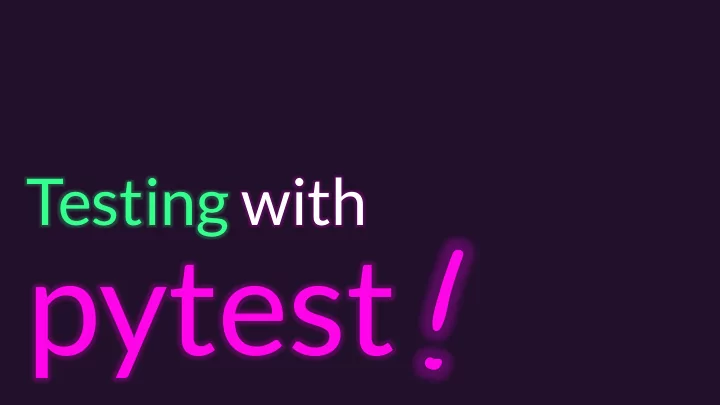

Testing with pytest
Big Idea: You can write a function to test the correctness of another function! • This is generally called unit testing in industry • Helps you confirm correctness during development • Helps you avoid accidentally breaking things that were previously working • The strategy: 1. Implement the "skeleton" of the function you are working on • Name, parameters, return type, and some dummy (wrong/naive!) return value 2. Think of examples use cases of the function and what you expect it to return in each case 3. Write a test function that makes the call(s) and compares expected return value with actual 4. Once you have a failing test case running, go correctly implement the function's body 5. Repeat steps #3 and #4 until your function meets specifications • This gives you a framework for knowing your code is behaving as you expect
Example: Writing and Testing a total Function (1/2) Let's write a function to add up all elements of a float list! Step 0) Implement the function skeleton: def total(xs: List[float]) -> float: return -1.0 # return a dummy value (wrong but correct type) Step 1) Think of some example uses... total([1, 2, 3]) should return 6.0 total([110]) should return 110.0 total([]) should return 0.0
Setting up a pytest Test Module • To test the definitions of a module, first create a sibling module with the same name, but ending in _test • Example name of definitions module: lessons.ls24_module • Example name of tests module: lessons.ls24_module_test • This convention is common to pytest • Then, In the test module, import the definitions you'd like to test • Next, add tests which are procedures whose names begin with test_ • Example test name: test_total_empty • To run the test(s), two options: 1. In a new terminal: python -m pytest [package_folder/python_module_test.py] 2. Use the Python Extension in VSCode's Tests Pane 4
Follow-Along: Testing total • Let's implement a function to sum the elements of an array • Function Skeleton: • What are our test cases?
Test-driven Function Writing • Before you implement a function , focus on concrete examples of how the function should behave as if it were already implemented. • Key questions to ask: 1. What are some usual arguments? • These are called use cases. 2. What are some valid but unusual arguments? • These are your edge cases. 3. Given those arguments, what is your expected return value for each set of inputs?
Test-Driven Programming: Case Study jo join in • Suppose you want to write a function named join • Its purpose is to make a string out of an int list xs's values where each element is separated by some delimiter. Example: joining xs with values [1, 2, 3] and delimiter "-" returns "1-2-3" • Its signature is this: def join(xs: List[int], delimiter: str) -> str 1. What are some usual input parameters? • These are called use cases. 2. What are some valid but unusual input parameters? • These are your edge cases. 3. Given those input parameters, what is your expected return value for each set of inputs?
Testing Use/Edge Cases Programmatically • After you have some use and edge cases, implement the skeleton of the function that is syntactically valid but intentionally incomplete • Typically this means define the function and do nothing inside of the body except return a valid literal value. For example: • Then, turn your use and edge cases into programmatic tests.
Testing is no substitute for critical thinking… • Passing your own tests doesn't ensure your function is correct! • Your tests must cover a useful range of cases • Rules of Thumb: • Test 2+ use cases and 1+ edge cases. • When a function has if-else statements, try to write a test that reaches each branch.
Recommend
More recommend